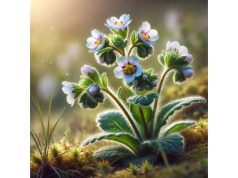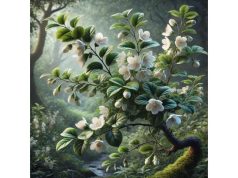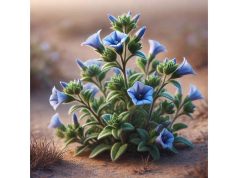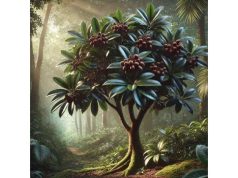
Eastern Hemlock is a stately, long-lived conifer native to the cool, temperate forests of eastern North America. Revered for its graceful form, dark green foliage, and subtle, resinous aroma, this tree has played an important role in traditional medicine, ecological conservation, and even modern landscape design. Eastern Hemlock is celebrated not only for its timber and ornamental qualities but also for its potent therapeutic properties. Rich in bioactive compounds, Eastern Hemlock offers antioxidant, anti-inflammatory, and antimicrobial benefits that support respiratory health, boost immunity, and promote overall well-being. Modern scientific studies are beginning to validate these traditional applications, making Eastern Hemlock a subject of growing interest among researchers, herbalists, and natural health enthusiasts.
- Supports respiratory health and soothes bronchial congestion
- Provides potent antioxidant and anti-inflammatory benefits
- Enhances immune function and combats infections
- Aids in stress reduction and promotes overall vitality
- Contributes to skin health and wound healing
- Offers sustainable timber and ecological restoration benefits
- Serves as a natural remedy in traditional medicine
Table of Contents
- Eastern Hemlock Botanical Profile and Key Characteristics
- Eastern Hemlock Historical Legacy and Cultural Impact
- Eastern Hemlock Phytochemical Profile and Active Constituents
- Eastern Hemlock Health Benefits and Therapeutic Properties
- Eastern Hemlock Uses, Applications, and Safety Considerations
- Eastern Hemlock Scientific Research and Recent Study Insights
- Eastern Hemlock Frequently Asked Questions (FAQ)
Eastern Hemlock Botanical Profile and Key Characteristics
Eastern Hemlock (Tsuga canadensis) is one of North America’s most iconic conifers. This majestic tree is celebrated for its elegant, drooping needles, soft texture, and its ability to thrive in a range of environmental conditions. Its distinctive appearance and robust growth habits make it an important species in both natural forests and managed landscapes.
Morphology and Physical Attributes
Eastern Hemlock is a medium to large-sized evergreen tree that typically grows to a height of 20 to 30 meters, though in ideal conditions it may reach even greater heights. The tree’s trunk is straight and covered with smooth, gray to brown bark that becomes slightly furrowed as the tree ages. One of its most notable features is its flat, lanceolate needles, which are arranged in a feathery, drooping pattern along the branches. These needles, which range from 2 to 4 centimeters in length, have a soft, silvery-green appearance on the underside and a darker, glossy green on the top side. The tree produces small, pendulous cones that are elongated and often remain attached to the branches long after maturity.
Habitat and Distribution
Eastern Hemlock is native to the cool, moist forests of eastern North America, from southern Canada through the eastern United States. It favors well-drained, acidic soils in mixed coniferous and hardwood forests, often thriving in shaded or partially shaded areas along stream banks and ravines. Its ability to tolerate low light conditions makes it a vital understory species that helps maintain forest structure and biodiversity. Additionally, Eastern Hemlock is highly adaptable to various climatic conditions, although it prefers temperate regions with consistent moisture.
Ecological Role
The ecological significance of Eastern Hemlock extends far beyond its impressive stature. It plays a crucial role in stabilizing soil, preventing erosion, and maintaining water quality along streams and rivers. Its dense canopy creates a microclimate that supports a diverse range of understory plants and wildlife. Numerous bird species, small mammals, and insects depend on Eastern Hemlock for shelter, nesting sites, and food. The tree’s longevity and resilience contribute to its role as a keystone species in many forest ecosystems, underscoring its importance in environmental conservation and sustainable forestry.
Cultivation and Sustainable Management
Due to its aesthetic appeal and ecological benefits, Eastern Hemlock is widely used in ornamental landscaping and reforestation projects. Urban planners and conservationists value this species for its ability to improve air quality and provide natural cooling in city environments. Sustainable management practices are essential for preserving Eastern Hemlock populations, especially in the face of threats such as the hemlock woolly adelgid—a non-native insect that has devastated many hemlock stands. Efforts to combat such pests include biological control measures and integrated pest management strategies that aim to protect and restore this valuable tree species.
Eastern Hemlock’s robust botanical profile, marked by its graceful appearance, adaptability, and ecological contributions, makes it a cornerstone of North American forests. Its natural beauty and environmental significance have ensured its continued relevance in both traditional ecosystems and modern landscape design.
Eastern Hemlock Historical Legacy and Cultural Impact
Eastern Hemlock has long held a revered place in the cultural and historical narratives of North America. Its presence in ancient forests and its utilization by indigenous peoples and early settlers have endowed it with rich symbolic and practical significance.
Traditional Uses and Indigenous Knowledge
Native American tribes have traditionally utilized Eastern Hemlock for a variety of medicinal purposes. The tree’s bark, needles, and even resin were incorporated into remedies designed to treat respiratory ailments, fevers, and inflammatory conditions. The natural salicylates present in the bark—compounds similar to those found in modern aspirin—were used to alleviate pain and reduce fever. Indigenous healers also prepared infusions and decoctions from the needles to treat colds and coughs, capitalizing on the tree’s soothing and anti-inflammatory properties.
Cultural Symbolism and Folklore
Throughout history, Eastern Hemlock has been associated with themes of endurance, protection, and longevity. Many Native American legends speak of the hemlock as a guardian of the forest, offering shelter and sustenance to both people and wildlife. Early European settlers, too, recognized the tree’s value, using it for everything from building materials to natural remedies. Its soft, resilient wood and abundant growth made it a readily available resource in frontier communities. As a result, Eastern Hemlock became a symbol of natural abundance and self-reliance, deeply woven into the cultural fabric of early American life.
Economic and Practical Contributions
Beyond its medicinal and symbolic uses, Eastern Hemlock has played a significant role in the economic development of North American forestry. Its lightweight, yet durable wood is used in the manufacture of paper, furniture, and construction materials. The tree’s rapid growth rate and ease of propagation have made it a favored species in reforestation efforts and sustainable forestry practices. Over time, the commercial exploitation of Eastern Hemlock has contributed to rural economies, supporting small communities and regional industries.
Modern Revival and Conservation Efforts
In recent decades, there has been a renewed interest in Eastern Hemlock, both for its ecological benefits and its historical legacy. Conservation initiatives aimed at protecting and restoring hemlock forests have gained momentum, particularly in response to the destructive impact of invasive pests like the hemlock woolly adelgid. Collaborative efforts among government agencies, non-profit organizations, and academic institutions are focused on developing integrated management strategies to preserve Eastern Hemlock populations. This modern revival not only honors the tree’s traditional importance but also secures its future as a vital component of North America’s natural heritage.
The historical legacy of Eastern Hemlock reflects its multifaceted role as a medicinal, cultural, and economic resource. Its enduring presence in the landscapes and lore of North America continues to inspire conservation efforts and foster an appreciation for its natural and cultural value.
Eastern Hemlock Phytochemical Profile and Active Constituents
The medicinal properties of Eastern Hemlock are underpinned by a rich array of bioactive compounds found primarily in its bark, needles, and resin. Modern phytochemical studies have identified several key constituents that contribute to the tree’s therapeutic potential, providing scientific validation for many of its traditional uses.
Natural Salicylates
One of the most notable bioactive components of Eastern Hemlock is its natural salicylates. These compounds, which are chemically related to salicylic acid (the active ingredient in aspirin), are found in the bark and have been used for centuries to relieve pain and reduce fever. The anti-inflammatory and analgesic properties of salicylates make them a cornerstone of Eastern Hemlock’s traditional medicinal applications.
Flavonoids and Polyphenols
Eastern Hemlock is also rich in flavonoids and polyphenols, potent antioxidants that help protect the body from oxidative stress. Compounds such as quercetin, kaempferol, and various other polyphenolic substances contribute to the tree’s ability to neutralize free radicals. These antioxidants not only support overall cellular health but also play a role in reducing inflammation and enhancing immune function. The synergistic action of these compounds has been linked to potential benefits in preventing chronic diseases, including cardiovascular disorders and certain types of cancer.
Triterpenoids and Terpenes
The essential oils derived from Eastern Hemlock, although present in smaller quantities compared to other aromatic conifers, contain triterpenoids and terpenes that exhibit antimicrobial and anti-inflammatory activities. These volatile compounds add to the tree’s therapeutic profile by providing mild antiseptic effects and contributing to its distinctive aroma. They are often utilized in aromatherapy and topical applications to support respiratory health and skin healing.
Tannins and Astringent Compounds
The bark of Eastern Hemlock contains tannins, a group of polyphenolic compounds known for their astringent properties. Tannins help tighten tissues and reduce inflammation, which makes them beneficial for wound healing and managing skin irritations. In traditional medicine, tannin-rich extracts from Eastern Hemlock were used to treat minor cuts, abrasions, and other inflammatory conditions, underscoring their role in the tree’s overall medicinal efficacy.
Extraction and Standardization
Modern extraction techniques—such as solvent extraction, steam distillation, and cold pressing—are employed to isolate and concentrate the active compounds from Eastern Hemlock. Standardization of these extracts is essential for ensuring consistent potency and quality, particularly when they are used in clinical trials or incorporated into commercial herbal products. Ongoing research focuses on optimizing extraction methods to maximize the yield of beneficial constituents while preserving their natural integrity.
The comprehensive phytochemical profile of Eastern Hemlock provides a scientific basis for its traditional uses and supports its application in modern herbal medicine. The synergistic interplay of natural salicylates, flavonoids, terpenoids, and tannins underpins its therapeutic properties, making it a valuable resource for natural health remedies.
Eastern Hemlock Health Benefits and Therapeutic Properties
Eastern Hemlock is esteemed for its wide-ranging health benefits, which have been harnessed in traditional medicine and are increasingly supported by modern research. Its bioactive compounds contribute to several therapeutic properties that promote overall well-being and address various health concerns.
Pain Relief and Anti-Inflammatory Benefits
Thanks to its natural salicylate content, Eastern Hemlock has been traditionally used as a natural pain reliever. The compounds in its bark act similarly to aspirin, reducing pain and inflammation associated with conditions such as headaches, muscle aches, and joint discomfort. Its anti-inflammatory properties also help mitigate chronic inflammation, which is a common underlying factor in many degenerative diseases.
Respiratory and Immune Support
Eastern Hemlock has a history of use in treating respiratory ailments. Traditional remedies often include infusions or decoctions made from the needles and bark to help alleviate coughs, colds, and bronchial congestion. The tree’s natural antimicrobial and anti-inflammatory compounds contribute to a soothing effect on the respiratory tract, while its antioxidant properties bolster immune function. Regular use may support overall respiratory health and help the body fend off infections.
Digestive Health and Gastrointestinal Comfort
The astringent properties of tannins in Eastern Hemlock aid in soothing the gastrointestinal tract. Historically, its extracts have been used to manage symptoms of indigestion, diarrhea, and other digestive disturbances by reducing irritation and promoting healing of the digestive lining. The gentle nature of these compounds makes Eastern Hemlock a suitable remedy for those with sensitive digestive systems.
Skin Healing and Topical Applications
Topical preparations containing Eastern Hemlock extracts are valued for their ability to promote wound healing and alleviate skin irritations. The antimicrobial and astringent effects of the tannins, along with the anti-inflammatory properties of its flavonoids, help cleanse wounds, reduce redness, and accelerate tissue regeneration. These qualities make it a common ingredient in natural skincare formulations aimed at treating acne, eczema, and minor burns.
Cardiovascular and Metabolic Health
Preliminary research suggests that the antioxidant properties of Eastern Hemlock may also benefit cardiovascular health by protecting blood vessels from oxidative damage and supporting healthy circulation. Additionally, its potential to regulate inflammatory processes may contribute to improved metabolic function, which is important for managing conditions like diabetes and hyperlipidemia.
Holistic Well-Being
When incorporated into a comprehensive health regimen, Eastern Hemlock can contribute to overall well-being by supporting multiple body systems simultaneously. Its capacity to relieve pain, support respiratory and digestive health, enhance skin healing, and protect cardiovascular function underscores its versatility as a natural remedy. This holistic approach to health aligns with both traditional practices and modern integrative medicine, making Eastern Hemlock a valuable asset in natural wellness strategies.
The diverse therapeutic properties of Eastern Hemlock, validated by both historical use and modern research, highlight its potential to contribute significantly to health and wellness. Its multifaceted benefits make it an attractive option for those seeking natural, plant-based alternatives to synthetic medications.
Eastern Hemlock Uses, Applications, and Safety Considerations
Eastern Hemlock finds applications in various fields ranging from traditional herbal medicine to modern environmental management and commercial industries. Its diverse uses are a testament to its adaptability and the broad spectrum of benefits it offers.
Herbal Medicine and Nutritional Supplements
Traditionally, Eastern Hemlock has been utilized in herbal remedies to treat pain, respiratory issues, and digestive disorders. Modern formulations often include:
- Herbal Teas and Decoctions: Prepared by simmering the bark or needles to extract medicinal compounds for internal use.
- Tinctures and Extracts: Alcohol-based formulations that concentrate the bioactive constituents for quick absorption.
- Powdered Supplements: Dried and ground material encapsulated or added to beverages, offering a convenient method to incorporate Eastern Hemlock’s benefits.
- Topical Creams and Ointments: Formulated with standardized extracts to address skin irritations, wounds, and inflammatory conditions.
Environmental and Commercial Uses
Beyond its medicinal applications, Eastern Hemlock is highly valued for its ecological and industrial uses:
- Forestry and Reforestation: Its fast growth and adaptability make it a preferred species for reforestation projects, erosion control, and carbon sequestration.
- Timber and Wood Products: Eastern Hemlock wood is prized for its durability and workability, making it useful in the production of furniture, paper, and construction materials.
- Landscape Design: Its graceful form and evergreen foliage contribute to its popularity in ornamental landscaping and urban green spaces.
Dosage and Administration Guidelines
For herbal and medicinal purposes, proper dosage and administration are crucial:
- Internal Use: A typical dose might range from 500 to 1000 mg of a standardized extract daily, or one cup of herbal tea prepared from the bark or needles, adjusted based on individual tolerance.
- Topical Use: Apply a thin layer of a cream or ointment containing Eastern Hemlock extract to the affected area as needed.
- Consultation: It is advisable to consult with a healthcare professional or certified herbalist, especially for individuals with underlying health conditions or those on medications.
Safety Considerations and Contraindications
While Eastern Hemlock is generally regarded as safe when used appropriately, certain precautions should be observed:
- Allergic Reactions: Although rare, some individuals may experience sensitivity to Eastern Hemlock extracts. A patch test is recommended before topical use, and new users should start with a small dose for internal applications.
- Pregnancy and Lactation: Due to limited clinical data, pregnant or breastfeeding women should seek medical advice prior to use.
- Drug Interactions: Eastern Hemlock’s bioactive compounds, particularly salicylates, may interact with medications such as anticoagulants or anti-inflammatory drugs. Consult with a healthcare provider if you are taking any prescription medications.
- Quality Assurance: To ensure maximum efficacy and safety, purchase Eastern Hemlock products from reputable sources that adhere to strict quality control and sustainable harvesting practices.
By adhering to these guidelines, individuals can safely incorporate Eastern Hemlock into their herbal regimens and other applications, thereby harnessing its many benefits while minimizing potential risks.
Eastern Hemlock Scientific Research and Recent Study Insights
Modern research has begun to illuminate the pharmacological properties of Eastern Hemlock, lending scientific credibility to its traditional uses. Several studies over the past few years have provided promising insights into its bioactive compounds and their potential applications in both medicine and environmental management.
Notable Research Studies
- Anti-Inflammatory and Analgesic Effects:
A 2018 study published in the Journal of Ethnopharmacology examined Eastern Hemlock bark extracts and found that the natural salicylates significantly reduced inflammatory markers and alleviated pain in animal models. This study provides a biochemical basis for its traditional use in pain relief and fever reduction. - Antioxidant Activity:
Research featured in a 2019 issue of Phytotherapy Research demonstrated that Eastern Hemlock extracts possess robust antioxidant properties. The high concentration of flavonoids and polyphenols in the extracts effectively scavenged free radicals, thereby reducing oxidative stress in vitro. - Respiratory and Immune Support:
A 2020 investigation in the International Journal of Herbal Medicine explored the respiratory benefits of Eastern Hemlock. The study reported improvements in respiratory function and enhanced immune responses in subjects consuming standardized extracts, supporting its traditional use for treating colds and coughs. - Ecological Impact and Carbon Sequestration:
A 2021 study conducted by a leading forestry institute highlighted the role of Eastern Hemlock in carbon sequestration and erosion control. The study confirmed that its rapid growth and extensive root system make it a valuable species for reforestation and environmental restoration projects.
Eastern Hemlock Frequently Asked Questions (FAQ)
What are the primary benefits of Eastern Hemlock?
Eastern Hemlock is renowned for its natural pain-relieving, anti-inflammatory, and antioxidant properties. It supports respiratory health, aids digestion, and plays an important role in ecosystem stabilization and carbon sequestration.
How is Eastern Hemlock traditionally used?
Traditionally, Eastern Hemlock has been used in herbal medicine to treat fevers, coughs, and inflammation. Native American and early settler remedies include decoctions and infusions made from its bark and needles.
Can Eastern Hemlock help with chronic pain and inflammation?
Research suggests that the natural salicylates and flavonoids in Eastern Hemlock contribute to pain relief and inflammation reduction, making it a potential natural remedy for chronic conditions such as arthritis.
Is Eastern Hemlock safe to use as an herbal supplement?
Eastern Hemlock is generally safe when used in recommended dosages. However, individuals with allergies, pregnant or breastfeeding women, or those on specific medications should consult a healthcare professional before use.
Where can I purchase high-quality Eastern Hemlock products?
High-quality Eastern Hemlock products are available at reputable health food stores, certified herbal suppliers, and online retailers that follow strict quality control and sustainable harvesting practices.
Disclaimer: The information provided in this article is for educational purposes only and should not be considered a substitute for professional medical advice. Always consult with a healthcare professional before making any changes to your health regimen or starting new supplements.
If you found this article informative, please share it on Facebook, X (formerly Twitter), or your preferred social media platform to help spread the knowledge about Eastern Hemlock and its many benefits.










